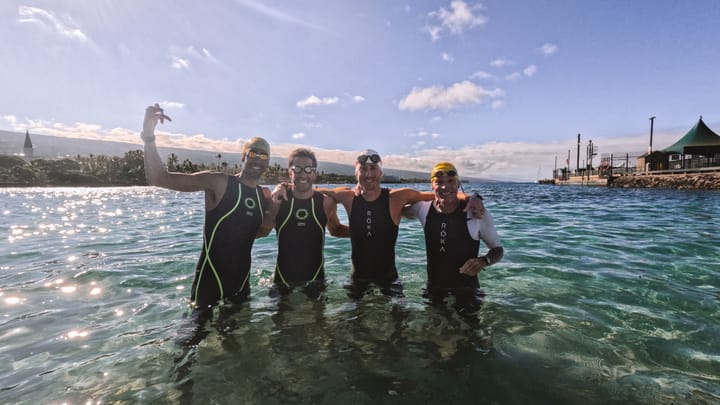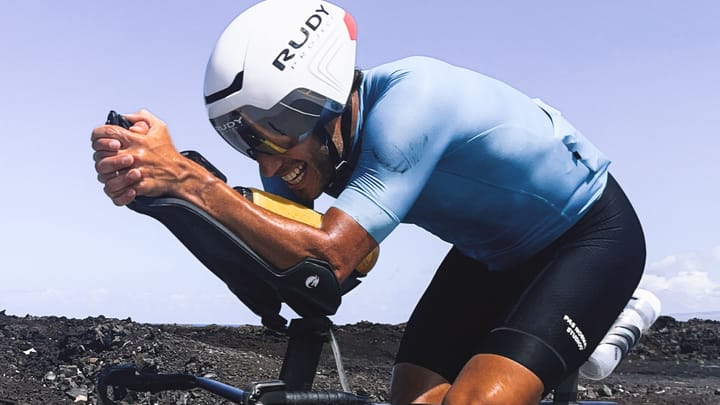Unlock More Power on the Bike with These Functional Stability Exercises
Doing a simple routine of squat, plank, and other functional stability exercises can help triathletes stop wasting energy through excess movement and deliver more power to the pedals.

The number of triathletes I see flopping around on the saddles of their bikes like fish out of water is scary. While incorrect set-up on the bike is one of the causes of this hyper-mobility through the lower back and hips, just as big of a contributor to this loss of efficiency is a lack of functional stability.
Not only does this leave you open to developing all sorts of overuse injuries but it also means much of the power and torque that you could be delivered to the pedals is lost and wasted as it is dissipated back up through your butt and lower back and hips. The purpose of this article is to provide you with a series of basic functional stability exercises to help you ‘lock off’ your pelvic (and shoulder) girdle(s) and deliver the power directly to where it needs to go – the pedals – to drive you along the road a couple of kilometres per hour faster.
The squat
Stand with your feet approximately 10 centimetres apart and pointing straight ahead. Squat down to about a 30-degree angle at the knee (shallow squat). Draw your belly button in towards your spinal column and keep your butt tight, at the same time flattening out your back. Place your hands on the outside of your knees. Push in with your hands, out with your knees. Weight is on the mid-arch to heel of your feet. From here, do three of each of the following movements – side to side, circle right, circle left, figure eight, front to back.
Lower from 30-degrees to 45-degrees (a half squat position) and repeat the above movements once more.
Lower from the half-squat to full squat position, with quadriceps almost parallel to the ground and repeat the movements once again.
Then return to the initial squat position and squat up and down five times with your toes straight – then your toes turned out slightly – and once more with your toes turned in slightly.
Crouching
Place your feet wide apart, bend your arms and legs and place your hands on the ground. Straighten your arms, then straighten your legs. Repeat this sequence three-to-five times with your toes straight ahead, then with them pointing out, and again with them pointing in.
Then complete the above sequence, but this time with your feet together. Then, with your feet wide apart, place your hands on the ground in front of you. Keep your abs tight, butt back and back flat. Rotate your hips from side to side 10 times.
The sumo wrestler
With your feet slightly wider than shoulder width and your toes straight, place your elbows in between your knees, hands together. Squeeze in with your knees.
From that position, do three of each of the following movements – side to side, circle right, circle left, figure eight, front to back.
Shoulder shrugs
Stand with your feet at shoulder distance apart. Bring your shoulders straight up and down, as much as you can move them three or four times. Then return to the starting position. Then move your shoulders forward as if to pinch your pectorals together. Repeat this three-to-five times. Once again, return to your starting position. Next up, move your shoulders down and in as if you’re pinching your shoulder blades together. Repeat this three-to-five times. The aim of this is to help you stabilise your shoulder girdle.
Bridging
Lie on your back, bend your knees and place your feet underneath them, keep your feet pointed straight ahead and approximately 30-centimetres from your butt. Push your hips up so that your lower back and upper legs are in a straight line. Hold this position for 10 seconds and repeat 10 times. Squeeze your butt cheeks together when in this raised position.
For variation, return to the starting position. This time, bring your hips up as in the previous motion but this time extend one leg out straight, and hold for 10 seconds. With your leg still extended, push back up to this raised position 10 times. Repeat the sequence using the other leg.
The plank and variations
Lie on your front with your elbows bent and under your chest. Push your body up from the floor so that your back is straight. Draw your belly button in (as though stopping the urine flow midway through a wee) and hold this elevated position for 30-seconds.
Then lie on your side with your elbow directly beneath your shoulder. Make a straight line from your feet to knees, hips and shoulders. Lift your hips up in a this ‘side plank’ position and hold for another 30 seconds. Return to your starting position on both elbows and then move to the opposite side and repeat the sequence.
Hyper-extensions
Lying on your stomach with your arms outstretched and legs straight, lift your arms and legs off the ground by contracting your lower back and hold for 30-seconds. Repeat the sequence 10 times.
Once you’ve completed this series of exercises, be sure to stretch your lower back and abdominals.
As a consequence of our largely sedentary lifestyle, many of our functional stability muscles become dysfunctional and lax. As a consequence, the base of support we require from which to leverage on the bike is less stable. Training these functional stabilisers with half a dozen exercises as suggested above will give you the edge when it comes to improving your efficiency on the bike, as well as swimming and running.





Comments ()